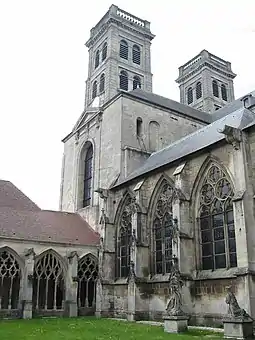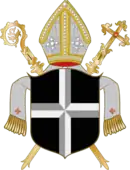Roman Catholic Diocese of Verdun
The Diocese of Verdun (Latin: Dioecesis Virodunensis; French: Diocèse de Verdun) is a Latin Church ecclesiastical territory or diocese of the Catholic Church in France. It is a suffragan diocese in the ecclesiastical province of the metropolitan Archdiocese of Besançon. The Diocese of Verdun corresponds to the département of Meuse in the région of Lorraine. The diocese is subdivided into 577 parishes.
Diocese of Verdun Dioecesis Virodunensis Diocèse de Verdun | |
|---|---|
 Verdun Cathedral and Cloister | |
 Coat of arms | |
| Location | |
| Country | France |
| Ecclesiastical province | Besançon |
| Metropolitan | Archdiocese of Besançon |
| Statistics | |
| Area | 6,211 km2 (2,398 sq mi) |
| Population - Total - Catholics | (as of 2014) 197,700 173,300 (87.7%) |
| Information | |
| Denomination | Catholic Church |
| Sui iuris church | Latin Church |
| Rite | Roman Rite |
| Established | Restored on 6 October 1822 |
| Cathedral | Cathedral of Notre Dame de Verdun |
| Patron saint | Blessed Virgin Mary Assumed in Heaven |
| Current leadership | |
| Pope | Francis |
| Bishop | Jean-Paul Gusching |
| Metropolitan Archbishop | Jean-Luc Bouilleret |
| Bishops emeritus | François Maupu |
| Website | |
| catholique-verdun.cef.fr | |
| Part of a series on |
| Lorraine |
|---|
 |
History
The diocese dates back to the 4th century. Traditionally the city was first evangelized around 332 by St Sanctinus, Bishop of Meaux, who became the first bishop. Sanctinus erected the first Christian oratory dedicated to St. Peter and St. Paul.[1][2]: pp.22–23
The first bishop known to history is St. Polychronius (Pulchrone) who lived in the fifth century and was a relative and disciple of St. Lupus de Troyes.[3] "Other bishops worthy of mention are: St. Possessor (470–486); St. Firminus (486–502); St. Vitonus (Vanne) (502–529); St. Désiré (Desideratus) (529–554), St. Agericus (Airy) (554–591), friend of St. Gregory of Tours and of Fortunatus; St. Paul (630–648), formerly Abbot of the Benedictine Monastery of Tholey in the Diocese of Trier; and St. Madalvaeus (Mauve) (753–776)."[4]
From 1624 to 1636, a large bastioned citadel was constructed on the site of the Abbey of Saint Vanne. The Church of Saint-Vanne was destroyed in 1832 and its cloister, which had been converted into barracks, was burned in 1870.[3]
Until 1801 Verdun was part of the ecclesiastical province of the Archbishop of Trier. On November 29, 1801 it was suppressed and added to the Diocese of Nancy. On October 31, 1822 the diocese was re-established.[3]
During World War I over 200 parishes fell under occupation by the German army and communication with the Bishop of Verdun practically cut off.[5] The administration of the parishes was confided to Thomas Louis Heylen, Bishop of Namur, who had been appointed vicar apostolic to French territory under German occupation.[6]
When the city came under bombardment the diocesan administration relocated to Bar-le-Duc and did not return until 1921. One hundred and fifty-three churches were destroyed and 166 damaged, including the Cathédrale Notre-Dame de Verdun, whose towers have never been rebuilt. Of 186 priests who enlisted, 13 were killed, 20 seriously wounded, and 50 taken prisoner. One hundred and sixty citations and diplomas of honor and 120 decorations were awarded to priests of the diocese.[5]
List of bishops
Early bishops
- ca. 346: St. Saintin
- 356–383: St. Maurus
- ???–420: Salvinus
- ca. 440: Arator
- 454–470: Polychronius[7]
- 470–486: Possessor
- 486–502: Freminus (Firminus)
- 502–529: Vitonus
- 529–554: Desideratus
- 554–591: Agericus
- v. 595: Charimeres
- v. 614: Harimeris
- ???–621: St. Ermenfred
- 623–626: Godo
- 641–648: Paulus
- 648–665: Gisloald
- 665–689: Gerebert
- 689–701: Armonius
- 701–710: Agrebert
- 711–715: Bertalamius
- 716: Abbo
- 716–722: Pepo
- 722–730: Volchisus
- 730–732: Agronius
- 753–774: Madalveus
- 774–798: Peter
- 798–802: Austram
- 802–824: Heriland
- 824–847: Hilduin
- 847–870: Hatto
- 870–879: Bernard
- 880–923: Dado[8]
- 923–925: Hugh I
- 925–939: Bernuin, son of Matfried I, Count of Metz, and of Lantesinde (sister of Dado)
- 939–959: Berengar
- 959–983: Wigfrid
- 983–984: Hugh II
- 984–984: Adalbero I, later Bishop of Metz (as Adalbero II). [9]
- 985–990: Adalbero II, cousin of predecessor.
Prince-bishops
- 990–1024: Haimont (Heymon)
- 1024–1039: Reginbert
- 1039–1046: Richard I
- 1047–1089: Theoderic
- 1089–1107: Richer
- 1107–1114: Richard II of Grandpré
- 1114–1117: Mazo, administrator
- 1117–1129: Henry I of Blois, deposed at the Council of Chalon (1129)
- 1129–1131: Ursion de Watronville[10]
- 1131–1156: Adalbero III of Chiny
- 1156–1162: Albert I of Marcey
- 1163–1171: Richard III of Crisse
- 1172–1181: Arnulf of Chiny-Verdun
- 1181–1186: Henry II of Castel
- 1186–1208: Albert II of Hierges
- 1208–1216: Robert I of Grandpré
- 1217–1224: John I of Aspremont
- 1224–1245: Radulf of Torote
- 1245–1245: Guy (Wido) I of Traignel
- 1245–1247: Guy (Wido) II of Mellote
- 1247–1252: John II of Aachen
- 1252–1255: James (Jacques) I Pantaléon of Court-Palais
- 1255–1271: Robert II of Médidan
- 1271–1273: Ulrich of Sarvay
- 1275–1278: Gerard of Grandson
- 1278–1286: Henri of Grandson
- 1289–1296: James (Jacques) II of Ruvigny
- 1297–1302: John III of Richericourt
- 1303–1305: Thomas of Blankenberg
- 1305–1312: Nicholas I of Neuville
- 1312–1349: Henry IV of Aspremont
- 1349–1351: Otto of Poitiers
- 1352–1361: Hugh III of Bar
- 1362–1371: John IV of Bourbon-Montperoux
- 1371–1375: John V of Dampierre-St. Dizier
- 1375–1379: Guy III of Roye
- 1380–1404: Leobald of Cousance
- 1404–1419: John VI of Saarbrücken
- 1419–1423: Louis I of Bar († 1430), administrator
- 1423–1423: Raymond
- 1423–1424: William of Montjoie
- 1424–1430: Louis I of Bar († 1430), administrator
- 1430–1437: Louis of Haraucourt
- 1437–1449: Guillaume Fillastre
- 1449–1456: Louis of Haraucourt
- 1457–1500: William of Haraucourt
- 1500–1508: Warry de Dommartin
- 1508–1522: Louis de Lorraine[11]
- 1523–1544: Jean de Lorraine (1498–1550), brother of predecessor
- 1544–1547: Nicolas de Mercœur (1524–1577), nephew of predecessor
- 1548–1575: Nicolas Psaume. The Bishopric was annexed to France in 1552. This was not formally recognised in the Empire until the Peace of Westphalia in 1648.
- 1576–1584: Nicolas Bousmard
- 1585–1587: Charles de Lorraine[12]
- 1588–1593: Nicolas Boucher
- 1593–1610: Eric of Lorraine[13]
- 1593–1601: Christophe de la Vallée, administrator
- 1610–1622: Charles de Lorraine,[14] nephew of predecessor
Bishops under French rule
- 1623–1661: François de Lorraine (1599 † 1672), brother of predecessor
- 1667–1679: Armand de Monchy d'Hocquincourt
- 1681–1720: Hippolyte de Béthune
- 1721–1754: Charles-François D'Hallencourt
- 1754–1769: Aymar-Fr.-Chrétien-Mi. de Nicolai
- 1770–1793: Henri-Louis Rene Desnos
Until 1801 Verdun was part of the ecclesiastical province of the Archbishop of Trier. On November 29, 1801 it was suppressed and added to the Diocese of Nancy. On October 6, 1822 the diocese was re-established.
After the Concordat
.jpg.webp)
- 1823–1830: Etienne-Bruno-Marie d'Arbou
- 1826–1831: François-Joseph de Villeneuve-Esclapon
- 1832–1836: Placide-Bruno Valayer
- 1836–1844: Augustin-Jean Le Tourneur
- 1844–1866: Louis Rossat
- 1867–1884: Augustin Hacquard
- 1884–1887: Jean-Natalis-François Gonindard
- 1887–1901: Jean-Pierre Pagis
- 1901–1909: Louis-Ernest Dubois
20th century
- 1910–1913: Jean Arturo Chollet
- 1914–1946: Charles-Marie-André Ginisty
- 1946–1963: Marie-Paul-Georges Petit
- 1963–1986: Pierre Francis Lucien Anatole Boillon
- 1987–1999: Marcel Paul Herriot
21st century
- From 2000 to September 2014: François Paul Marie Maupu
- From September 2014: Jean-Paul Gabriel Émile Gusching
References
- "Les grands sites religieux du diocèse de Verdun au Moyen-Âge". Diocèse de Verdun.
- Healy, Patrick (2006). The Chronicle of Hugh of Flavigny: Reform and the Investiture Contest in the Late Eleventh Century. Ashgate Publishing, Ltd. ISBN 978-0-7546-5526-8.
- Goyau, Georges. "Diocese of Verdun." The Catholic Encyclopedia Vol. 15. New York: Robert Appleton Company, 1912. 21 January 2023
 This article incorporates text from this source, which is in the public domain.
This article incorporates text from this source, which is in the public domain. - "Diocese of Verdun". CatholiCity. Retrieved March 22, 2013.
- "Verdun, Diocese of", The Catholic Encyclopedia: Supplement 1, Encyclopedia Press, 1922
- [Simon, A., "Heylen (Thomas-Louis)", Biographie Nationale de Belgique, vol. 32 (Brussels, 1964), 295-299.
- Smith, William; Wace, Henry (1887). A Dictionary of Christian Biography, Literature, Sects and Doctrines, vol 4. Little, Brown & Company. p. 436.
- Gerzaguet, Jean-Pierre. "Dado of Verdun". Encyclopedia of the Medieval Chronicle, (Graeme Dunphy, ed.) Brill Online, 2016. Reference. 09 March 2016 (Wayback Machine 17 october 2016)
- Son of Frederick I, Duke of Upper Lorraine
- François-Alexandre Aubert de La Chesnaye Des Bois. "Dictionnaire de la noblesse : contenant les généalogies, l'histoire et la chronologie des familles nobles de France", (Paris: Schlesinger Brothers, 1867), p. 993.
- Son of René II, Duke of Lorraine.
- (1561–1587), bishop of Toul from 1580 to 1587, son of Nicolas de Mercœur.
- (1576–1623), son of Nicolas de Mercœur.
- Saive Numismatique
![]() This article incorporates text from a publication now in the public domain: Herbermann, Charles, ed. (1913). "Diocese of Verdun". Catholic Encyclopedia. New York: Robert Appleton Company.
This article incorporates text from a publication now in the public domain: Herbermann, Charles, ed. (1913). "Diocese of Verdun". Catholic Encyclopedia. New York: Robert Appleton Company.
Books
- Société bibliographique (France) (1907). L'épiscopat français depuis le Concordat jusqu'à la Séparation (1802-1905). Paris: Librairie des Saints-Pères.
External links